 |
| Semantic Networks |
|
  


|
  
|
|
|
| |
|
Introduction
In this lesson we will study semantic networks not for the topic itself but to enable us to better understand how we can make emergency management more effective. Semantics is the study of meaning. A semantic network is a specialized representation for an Ontology. |
| |
| Definition: |
Ontology: An explicit specification of a conceptualization.
Source: Tom Gruber "A translation approach to portable ontology specifications". In: Knowledge Acquisition 5, (1993) pp. 199-220 |
|
| |
| One of the basic theses underlying semantic networks, sometimes called associative networks, is that concepts are often defined by their relationship to other concepts. |
| |
| Definition: |
Semantic Network: a
simple knowledge representation scheme that uses a graph of
labeled nodes representing concepts, events and other objects and labeled directed arcs to represent the relationships between nodes.
Source: M. Ross Quillian. "Semantic Memories", In M. M. Minsky, editor, Semantic
Information Processing, pages 216-270. Cambridge, MA: MIT Press, 1968
|
|
| |
In the emergency management field today there is some ambiguity regarding the interpretation of important concepts as well how to operationalize those concepts. This has arisen because it is a relatively new field thaat is still evolving and some of the concepts have come from other disciplines.
Semantic network representations are not new. Many of us studied biology by learning the hierarchical taxonomy originated by Carl Linnaeus.
|
Biological Classification System
Kingdom, Phylum, Class, Order, Family, Genus, and Species |
| |
| By learning the classifications and their characteristics we could differentiate one animal from another or make statements as to their closeness to one another.
|
| |
| The figures below show two different examples of semantic network representations. |
| |

|
| Encyclopedia of Artificial Intelligence, Stuart C. Shapiro (ed.), Wiley, 1987, second edition, 1992
|
| |
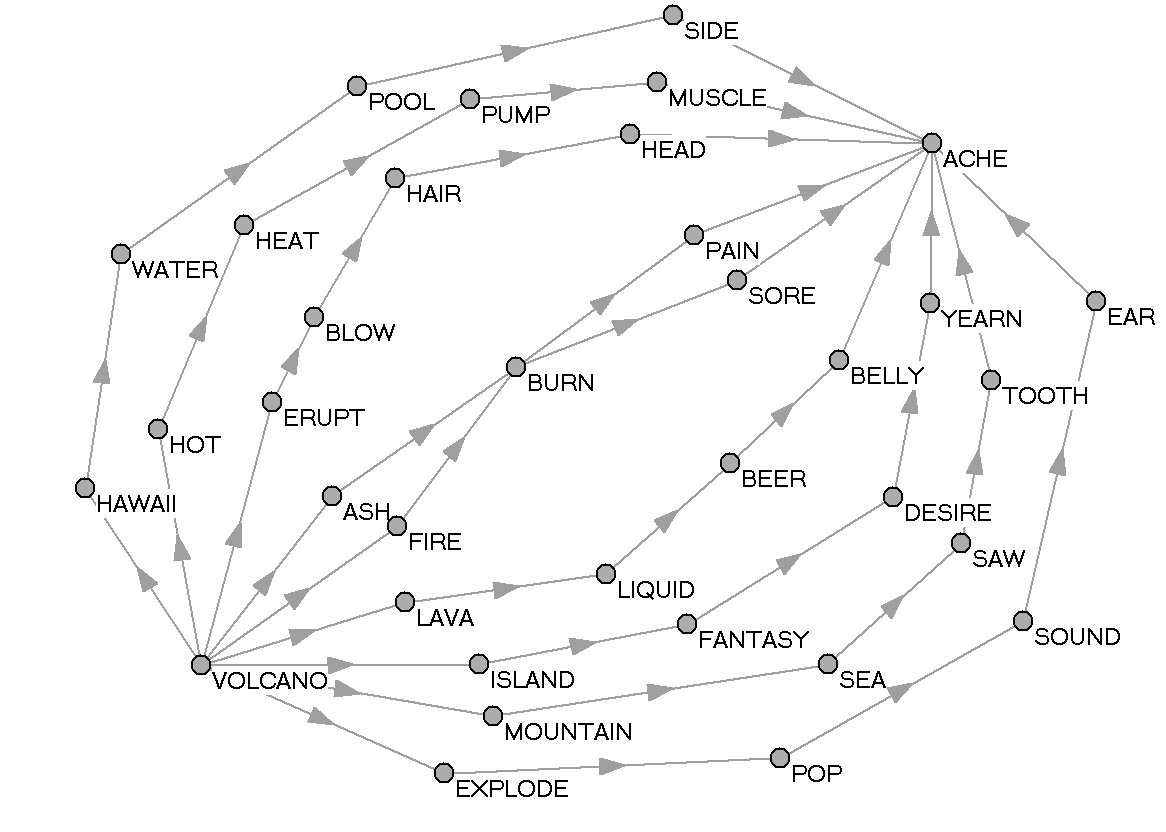
|
| Mark Steyvers and Joshua B. Tenenbaum, The Large-Scale Structure of Semantic Networks:
Statistical Analyses and a Model of Semantic Growth, Cognitive Science 29 (2005) 41?78 |
| |
Kinds of semantic networks
In addition to the semantic network being an ontology, we can write software to navigate the network to accomplish some interesting things.
Sowa (Sowa, John F. (2000) Knowledge Representation: Logical, Philosophical, and Computational Foundations, Brooks/Cole Publishing Co., Pacific Grove, CA) has classified six common types of semantic networks which are commonly used in artificial intelligence (AI) and other fields:
- Definitional networks emphasize the subtype or is-a relation between a concept type and a newly defined subtype. The resulting network, also called a generalization or subsumption hierarchy, supports the rule of inheritance for copying properties defined for a supertype to all of its subtypes. Since definitions are true by definition, the information in these networks is often assumed to be necessarily true.
- Assertional networks are designed to assert propositions. Unlike definitional networks, the information in an assertional network is assumed to be contingently true, unless it is explicitly marked with a modal operator. Some assertional netwoks have been proposed as models of the conceptual structures underlying natural language semantics.
- Implicational networks use implication as the primary relation for connecting nodes. They may be used to represent patterns of beliefs, causality, or inferences.
- Executable networks include some mechanism, such as marker passing or attached procedures, which can perform inferences, pass messages, or search for patterns and associations.
- Learning networks build or extend their representations by acquiring knowledge from examples. The new knowledge may change the old network by adding and deleting nodes and arcs or by modifying numerical values, called weights, associated with the nodes and arcs.
- Hybrid networks combine two or more of the previous techniques, either in a single network or in separate, but closely interacting networks.
|
| From the examples above and the types of semantic networks, you can see that the implementation of semantic networks vary widely. We have selected a particular implementation for our use in the materials that follow. We have made some simplifying and unifying assumptions. Other representations might serve us equally well. However for didactic purposes, we use the following specifications. |
| |
|
Semantic Networks and Emergency Management
The field of emergency management is replete with concepts. Arguably, the central of these concepts is Situational Awareness and Common Operating Picture. Understanding these two concepts is essential to being an effective emergency manager. Unfortunately official sources have defined these terms differently (there is even a difference of opinion as to whether the first term should be situational or situation awareness).
|
| |
| The elements of these definitions involve the invocation of other concepts which need to be defined. The ultimate purpose of this lesson is to create a semantic network that better describes what we truly understand to be the field of emergency management. |
| |
| Definition: |
Situational Awareness: The ability to identify, process, and comprehend the critical elements of information about an incident.
Source: FEMA National Response Framework Resource Center www.fema.gov/emergency/nrf/glossary.htm.
|
|
| |
| Definition: |
Common Operating Picture: A continuously updated overview of an incident compiled throughout an incident's life cycle from data shared between integrated systems for communication, information management, and intelligence and information sharing. The common operating picture allows incident managers at all levels to make effective, consistent, and timely decisions. The common operating picture also helps ensure consistency at all levels of incident management across jurisdictions, as well as between various governmental jurisdictions and private-sector and nongovernmental entities that are engaged.
Source: FEMA National Incident Management Syatem www.fema.gov/emergency/nims/Glossary.shtm.
|
|
| |
|
| Semantic Network Specification |
| |
What follows is a specification for a semantic network that resulted from making deliberate choices from the possible representational options.
As we saw earlier a semantic network is composed of nodes representing concepts, events or objects and arcs which connect the nodes and represent relationships between the concepts. often these are displayed graphically with the following elements. |
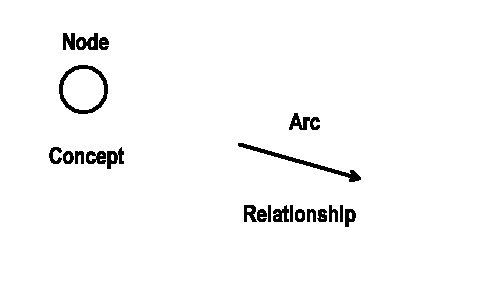
|
| The simplest semantic network is shown below. Here two concepts are connected by two relationships. |
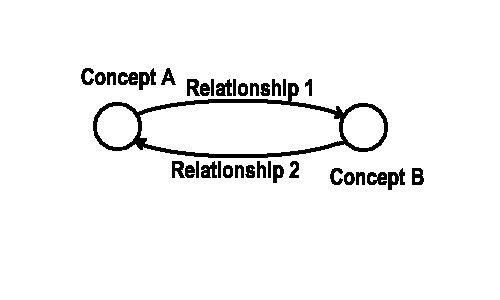
|
| The semantic network depicted below is an example of the network above. In this case the concepts of emergency and flood are related together by two relationships: Broader Term (BT) and Narrower Term (NT). In essence the diagram represents: "Flood is a type of Emergency."
In artificial Intelligence (AI) these relationships are often called Is-A relationships. |

|
| Since concepts are always related in both directions, we will simplify the arc representation by using a single line with tho arrows as shown below. |
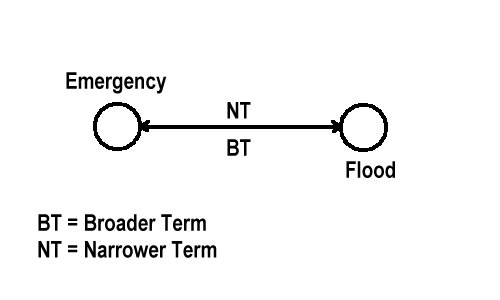
|
| To make the semantic network more representative and powerful, we must specify the characteristics of the concepts contained. One way of doing this is to appeal to some well-accepted authority. Below are two definition for our simple semantic network concepts. |
| |
| Definition: |
Emergency: Any incident, whether natural or manmade, that requires responsive action to protect life or property.
Source: FEMA National Incident Management System www.fema.gov/emergency/nims/Glossary.shtm.
|
|
| |
|
| |
We can make several observations at this point. First, Our resultant network is going to depend on our definitions of concepts. The emergency literature is filled with definitions for these two concepts. Some of these definitions are materially different, others are not. See for example the definition of "flood" in the Stafford Act. We could, for example, create a concept definition that was the combination of these deffinitions. At the minimum our semantic network give us a framework for ambiguity or differences in conceptualizations.
Second, our network places "Flood" as a narrower term with respect to "Emergency." This implies that a flood has the characteristics of an emergency (it requires response and it threatens life and property), a property called inheritance. In addition, a flood has a characteristic that is particular to the flood (inundation) as a particular type of emergency. In complex semantic netwworks a concept might inherit properties from more than one other concept.
Also note that our semantic network represents classes, not instances. For example, "The Great Johnstown Flood of 1889" is not a concept. Its attributes consist of measured characteristics of the concepts for which it is an example.
|
| |
| The semantic network below is an example of a Full Term/Abbreviated Term relationship. In some types of semantic network standards, abbreviations/acronyms would be represented as attributes of the full term. Here we elect to treat the abbreviation/acronym as a new term related to the full term. |
| |
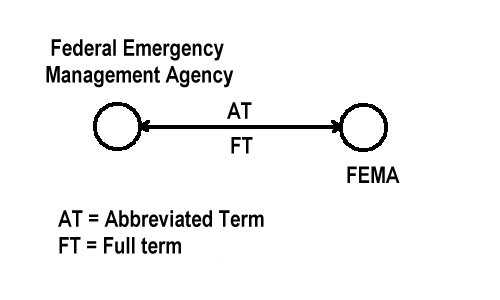
|
| |
| When two terms are essentially identical, we represent them with the Same Term relationship which is symmetric. |
| |

|
| |
| When two terms are opposites, we represent them with the Opposite Term relationship which is symmetric. |
| |
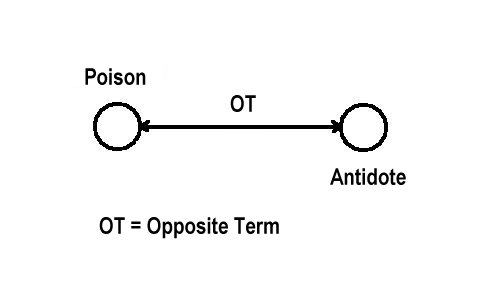
|
| |
| When two terms have a relationship that is not one of the defined relationships above, we represent them with the Related Term relationship which we consider to be symmetric. We use the related term for simplicity purposes. In reality the Related Term relationship may represent any number of relationships: Causes/Is-Caused_By, Requires/Is-Required-By, Above/Below, Parent/Child, etc. |
| |
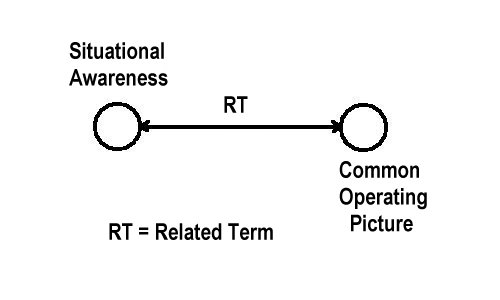
|
| |
| We can create a larger semantic network by building off one of the concepts. This is shown below. |
| |
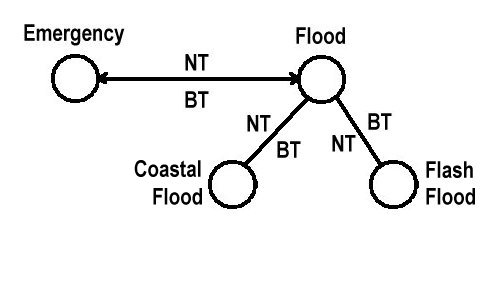
|
| |
| We can expand the network again. |
| |

|
| We can arbitrarily expand the semantic network. Hopefully, it will eventually include all of the concepts in our domain. In fact, stopping is an issue that we will have to deal with. We could get ridiculous and expand our network to the subatomic level. Normally we stop when we reach a term that is beeyond the domain that we are studying or that the term has a common definition e.g."water." |
| |
| Emergency Semantic Network |
| |
| Source | Term | Definition |
| FEMA NIMS Glossary | Emergency | Any incident, whether natural or manmade, that requires responsive action to protect life or property |
| FEMA FloodSmart Glossary | Flood | A general and temporary condition of partial or complete inundation of two or more acres of normally dry land area... |
| | | |
| National Weather Service Manual | Flash Flood | A rapid and extreme flow of high water into a normally
dry area, or a rapid rise in a stream or creek above a predetermined flood level, beginning
within six hours of the causative event (e.g., intense rainfall, dam failure, ice jam). However, the
actual time threshold may vary in different parts of the country. Ongoing flooding can intensify
to flash flooding in cases where intense rainfall results in a rapid surge of rising flood waters. |
|
| |
| Term 1 | Relation | Term 2 |
| Emergency | BT | Flood |
| Flood | NT | Emergency |
| Flood | BT | Tidal Flood |
| Tidal Flood | NT | Flood |
| Flood | BT | Flash Flood |
| Flash Flood | NT | Flood |
| Flash Flood | RT | Storm |
| Storm | RT | Flash Flood |
| Dam Breach | RT | Flash Flood |
| Flash Flood | RT | Dam Breach |
|
| |
| State | Site | Language | Term | URL |
| PA | PEMA | English | Flood | http://www.pema.state.pa.us |
|
| Spreadsheets:
|
| |
| The table below gives selected web site URLs for glossaries in use by federal and nationalagencies related to emergency management. |
| |
|
| |
| The table below gives the web site URLs for the Citizen Corps sites for the states in FEMA Region III. |
| |
|
| |
| The table below gives the web site URLs for the emergency management sites for the states in FEMA Region III. |
| |
|
|
| Exercise: |
Your task is to create a resource database for emergency management. You will:
- Identify a set of terms that exemplify the core concepts of what is emergency management.
- Develop a set of definitions for each term.
- Relate the concept terms
- Identify web pages from the federal and state web sites that provide material related to each term.
|
|
| |
|
|
|
|
|
| Copyright © 2011, 2012 Ken Sochats |
























